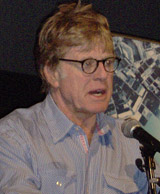Robert Redford and Laura Dunn on 'The Unforeseen'
 [Editor's note: The Unforeseen, a documentary about development in Austin that focuses on Barton Springs, has been playing at Alamo Drafthouse (first at South Lamar, currently at Ritz) for a few weeks now and is apparently still popular enough to stick around. If you haven't seen it, now's the time -- the lovely cinematography makes the documentary worthwhile to see in theaters. To whet your interest in the film, here are some excerpts from director Laura Dunn and producer Robert Redford, who were in Austin in March to promote the film.]
[Editor's note: The Unforeseen, a documentary about development in Austin that focuses on Barton Springs, has been playing at Alamo Drafthouse (first at South Lamar, currently at Ritz) for a few weeks now and is apparently still popular enough to stick around. If you haven't seen it, now's the time -- the lovely cinematography makes the documentary worthwhile to see in theaters. To whet your interest in the film, here are some excerpts from director Laura Dunn and producer Robert Redford, who were in Austin in March to promote the film.]
Laura Dunn, director: "A little over 5 years ago now, a group of us who really love Austin came together and started working on this film. We saw it as being the story of the long-running battle over Barton Springs and specifically lensing it as a microcosm for what's going on everywhere in communities across the globe. As we grow, how do we protect our most precious natural resources, like Barton Springs?
"I worked on this film for over 5 years and interviewed hundreds of people ... everyone from real estate developers to environmentalists to lobbyists to politicians to swimmers to long-time Austinites to artists, scientists, you name it. It was pretty exhausting.
"Lee Daniel, our cinematographer, his work is beautiful. It shines in this film. It's a real honor to work with him. He and I shot all over town, from underwater shots of Barton Springs to Hill Country ranch land to traffic at I-35 to hanging from a crane on top of the Frost Bank tower when it was under construction.
"I also had a wonderful assistant who helped me comb through hours of archival footage -– newsreels from 1970s, '80s, '90s to today at the Austin History Center.
We wove all that stuff together and distilled it down to the essence of what is going on here in Austin.
"The Unforeseen has been called 'a poetic meditation' on the American Dream. I’m honored by that description.
"How do we protect this place that we love? This film is not designed as a polemic but as a calling to people in Austin to reflect on that and the future.
"The film premiered at Sundance in 2007 and recently won the Independent Spirit in Truth and Fiction Award."
Robert Redford, producer: "I'll try to distill my involvement in this. I think Laura covered part of it, starting with the fact that my mom's side of the family goes back four generations in the San Marcos/Austin area. So I spent much of my young life here, in the summers with my grandfather on Lake Austin. He built one of the first houses there.
"As far as Barton Springs is concerned, even though I grew up in Los Angeles, a lot of my introduction to the land and elements, resources like water, particularly from natural sources, really started here.
"My citizen's work in the environment was connected to that impact that the beautiful land and water around Austin made on me so many years ago as a young kid. In about 1989 or so, I became aware of the struggle of a few local people to try to ward off what looked like a Godzilla footprint on its way into Austin in the form of development over a sensitive area. Not that development itself was wrong, but where it was going seemed very wrong.
"Destroying a natural aquifer and springs was something that I felt was wrong, particularly since that was where I'd learned to swim. When I was 6 years old, I was tossed in the springs. I thought as a little kid that it was pretty impressive to learn how to swim alongside the fishes.
"I wanted to help save Barton Springs from development in any way I could. So I came in 1989, and I had been coming here for several years since, to help Bill Bunch and some folks like that who were working very hard to raise money for the fight to save the aquifer and springs. It looked like one of those odds against Goliath situations, but I thought 'we can do what we can do.'
"Texas Governor Ann Richards was involved, Jim Hightower was also involved. So this went on for several years and then I was just committed to helping them as long as they could stay alive in this fashion. In those early days, it looked like the odds were against us.
"In any case, a few years ago I get a call from Terry Malick, who is a colleague and a friend. Terry had moved here to Austin. Malick and I had a couple of projects in development together. He said one day, 'Look, I'm aware of your involvement here in Austin and I was wondering if you would like to join me in executive-producing this film. I've found this girl out of graduate school whom I think is very talented.'
"We discussed what kind of film it would be and that it might have a bit of a spiritual tone to it which would make it a little more interesting. So I said absolutely.
"Now, I'll speak of the film and how my own interests in Sundance connect to it. I have felt for a long time that documentaries were extremely important. I got involved in supporting, making, narrating, and producing very small documentaries in the early '70s. All through the '70s and into the '80s, I put a lot of energy into documentaries because I believed in them. I also believed that they would at some point move out of the academic textbook feeling of talking heads and charts and move closer to real film. I wanted to be a part of that growth and development.
"So when I started the film festival [Sundance] in 1986, as soon as we knew that it would survive (which was about 4 or 5 years into it), I made my own full-length documentary having to do with Leonard Peltier, one of the AIM fellows who was in prison around the Pine Ridge issue. It was called Incident at Oglala. That took me further into the experience [of making a documentary].
"Then I felt the institute and the non-profit arm, which was the festival, now had a platform that we could use as a springboard to start promoting documentaries more heavily. So we did that. We started about 1988 or '89. Each year we would push it further and further. We would form something called the House of Docs, where all the documentary filmmakers could come gather together in a green room atmosphere and create a community for themselves. We would give them special attention in the festival and we would increase that attention so that there were screens just for documentaries. We would promote them heavily.
"So as this developed over the years, along came what I was hoping for, which was a whole new brand of young filmmakers that were interested in film but also interested in the truth-telling capability of documentaries.
"So enter Laura Dunn. She, in my opinion -- I'm proud of this film on a number of levels -- I don't want to ignore the top one, which is I think it's good filmmaking. What excites me about this is that it takes the film, by introducing more art into it and crossover art like poetry, like the prose poetry of Wendell Berry, and having the visual photography match that -– something that could be very dry and very boring -– is made very pleasing to me. It has something to do with why the film is being so well received.
"It's a very special film for me for those reasons and I'm very proud of Laura and her crew."
Dunn: "The name The Unforeseen comes from a poem by Wendell Berry, from his poem called 'Santa Clara Valley.' It's a really beautiful poem that struck me early on as we were making this film. The first lines of the film start with the first few lines of the poem. The first four stanzas of the poem describe this world in which everything is foreseen. Every landscape has been paved over with the image of man. There's nothing natural left. It describes the despair of that (which I often personally feel). In the end, he comes across this little pool of water. In that little pool of water, there's all of this life springing forth, sparrows and such. It's the resilience of Nature and that which is unforeseen, that which we don't control, that which is unexpected, that is important. For me it was a beautiful poem that spoke to Barton Springs as something that is 'unforeseen' here in our landscape in Austin, and points to the spiritual elements that the film is reaching for. The hope really resides in that which we don't control.
"I hope this film will inspire those who have been at this for a long time, that it will re-invigorate some of the old guard who have really pioneered this battle to protect Barton Springs and that it will inform the newcomers."
Redford: "I've been heavily involved in the environmental movement for over 35 years now, trying to protect wild places, the natural resources that we have that are shrinking pretty fast. This film is a microcosm of what's happening throughout this country.
"As much as I love literature and books, I think film is the new language and therefore we're going to be using that to tell stories and communicate. Part of the strength of the film is you see the issue from both sides. Developer Gary Bradley is shown as a sympathetic character from a hardscrabble background and the environmentalists are also sympathetic characters. We allow the audience a little space to think of their own feelings about it."
Dunn: "I felt like including Bradley's perspective would bring something new to the discourse."
Redford: "It brings more of a balanced view to the issue."

